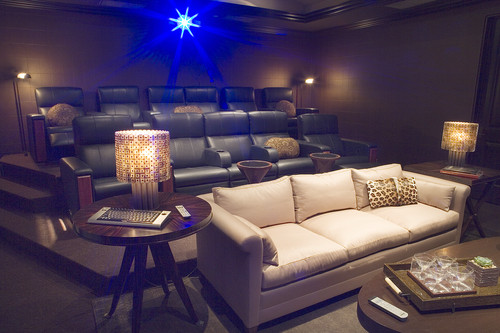Size matters when choosing which room to convert. Former Atlanta Falcons cornerback Elijah Williams chose a 600-square-foot room for setting up a theater in his Orlando home.

The theater room of Lori and Jen-Hsun Huang in Los Altos, Calif., designed by SFA Design, is couched in comfort
"We divide it down the middle, so that fans from each team have their own side," he says. "That way we can yell and scream at each other throughout the game."
When former players from opposing college teams gather to watch a game in Williams' home, the losing team has to wear the winners' jerseys for a week. "Once, Tennessee lost to Florida, and Chuck Smith [Falcons' defensive lineman weighing about 260 pounds] had to wear my jersey," Williams says, laughing. "I was weighing about 185 at the time, so he looked pretty funny."
To keep nonfan neighbors happy, soundproofing is essential. Sue Firestone, CEO of SFA Design in Santa Barbara, Calif., designed rooms for San Francisco Giants outfielder Barry Bonds and Keyshawn Johnson, former wide receiver for the New York Jets, Tampa Bay Buccaneers, Dallas Cowboys and Carolina Panthers.
"It's important to get a designer and technical consultant involved right away," she says. "You are going to need padding for the walls and floor and appropriate wiring for the technology. I also recommend upholstering the walls, which could be done in leather or a plush mohair."
Carefully choosing coverings for the walls and ceiling of the room also can enhance the sound. "When we add acoustical sound treatment to the room, the surround sound sounds much better," says Ted Hollander, vice president of Absolute Sound in Winter Park.
Tim Watson, former safety for the Kansas City Chiefs, New York Giants and Philadelphia Eagles, added R-19 insulation to his family's home theater, near Tampa. "Normally in Florida we don't have insulation in our inner walls, but we put it all around the room, and also above in the ceiling, to decrease noise," he says.
Once the room is wired, the soundproofing is applied and the equipment is installed, a home-automation professional can simplify access to the technology in the room. John Gutekunst, regional director of Crestron Inc., a company that manufactures home-automation devices, advocates hiring a professional to create a custom technology interface that appeals to the individual user.

The theater room at the 2006 Esquire House 360: Ultimate 21st-century Bachelor Pad in Beverly Hills, Calif. The room, designed by SFA Design, seats 20 and has a 92-inch front projection screen
"We can eliminate all those buttons on remotes that don't get used," he says. "And we can give users one button that controls more than one device, which eliminates the need to use multiple remotes."
The sky is the apparent limit -- literally -- when it comes to home-automation design. "Barry Bonds put a galaxy of light in his ceiling -- a magnificent fake sky," says Firestone.
Home automation makes it easy to multitask while watching the big game.
"We can help with the inclusion of subsystems to control lights, drapes, heating and air," Gutekunst says. "We can also integrate the home theater with the home's security system, so that there can be a picture-in-picture of people at your door.
"Then we can give you a button to turn on the Jacuzzi so that when the movie is over, you can get in the Jacuzzi. We can also put caller ID on the screen so that if someone calls during the game, you can see who is calling."
A major fundamental design decision is whether to make a movie theater-style room with built-in platforms for seating or a room that feels more like a family room. "My wife and I had this debate for six months while we were building our home," Watson says. "Guess who won."
Watson's room is decorated with his jerseys, trophies, game balls and pictures of his teammates over the years. "My sons are now invading the room with their championship trophies," says Watson.
Sons Tré, 11, and Christian, 8, and daughter Alexus, 10, join Watson and wife Christa to watch games. "I'm glad we went with the family room design," Watson says. "My faith and my family come first, and this is one way we can all come together."
Firestone also advocates designing the home theater around the family. "You should really think about how you are going to use the room," she advises. "If a house has a family room and a media room, and both have big screens in them, the family will tend to use the family room and not use the media room."
The classic home theater with platform seats is thus fading in popularity to multifunctional rooms that can serve as home theater in combination with family room, guest room or even home office.
"People are thinking more about changing the function of a room, instead of adding a room," says Firestone. "Sometimes a house gets too big, and people get too isolated. A home should be for bringing people together."



![A Tranquil Jungle House That Incorporates Japanese Ethos [Video]](https://asean2.ainewslabs.com/images/22/08/b-2ennetkmmnn_t.jpg)









